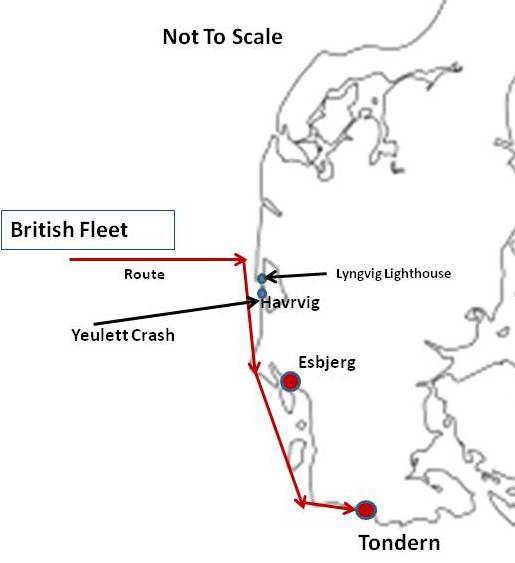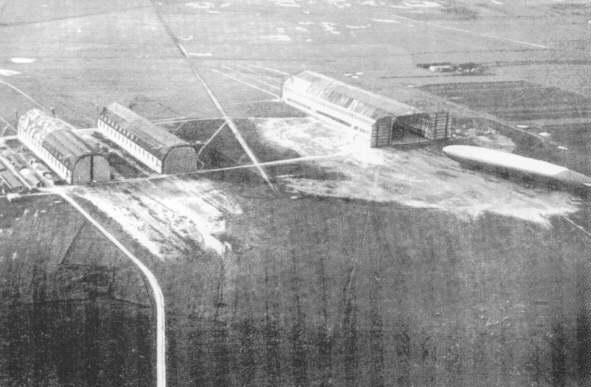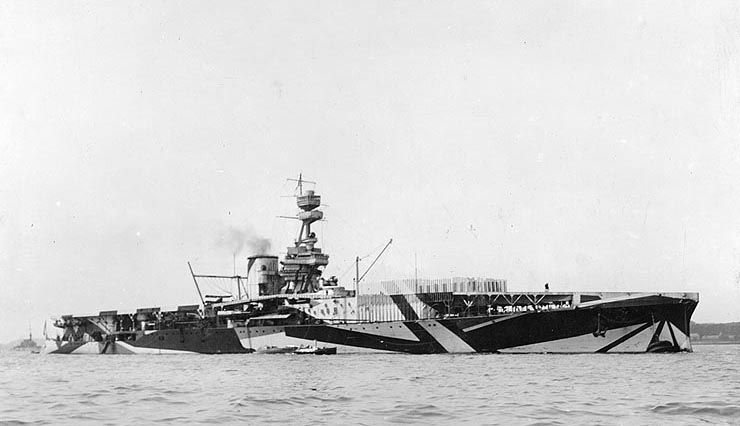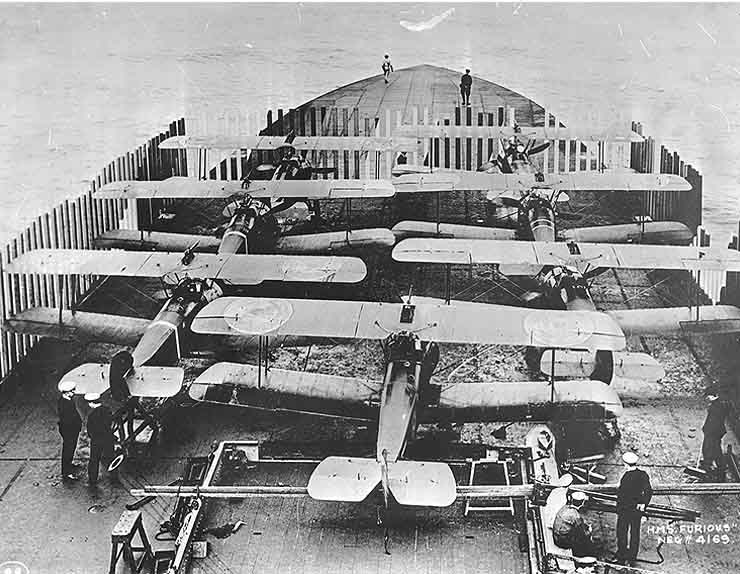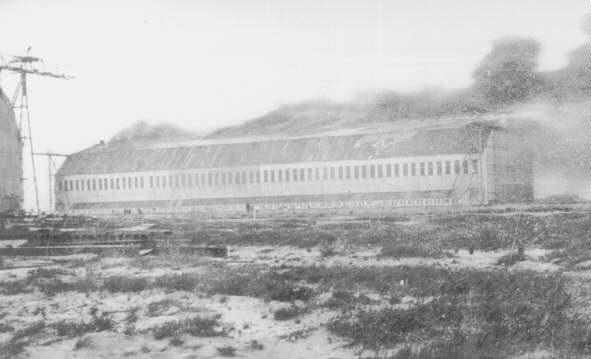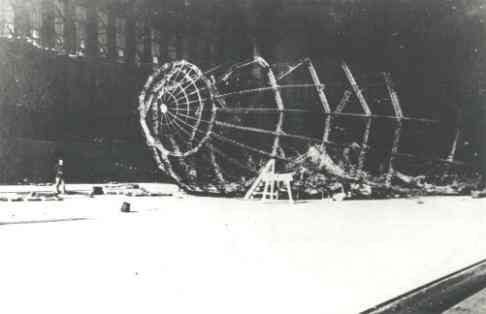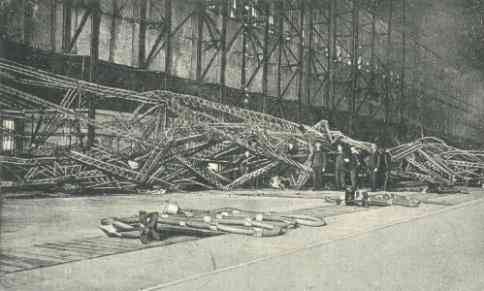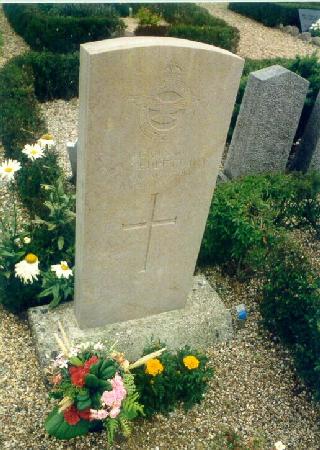Walter "Toby" Yeulett DFC
The Raid on Tondern 1918
Unless otherwise stated all material on this site is © William Casey and may not be reproduced without permission. Please contact me if you wish to use anything. Thanks.
You have been redirected to the new site http://www.tondernraid.com . Please update your Links! |
The Story of the Raid on Tondern19th July 1918All the pictures are "clickable" for larger versions
Since the beginning of the war Zeppelins had been a constant threat to both shipping and the civilians of England and the Royal Naval Air Service had made a number of attempts to bomb the bases but, always operating at maximum range and in limited numbers, success was always going to be hard to come by. The modifications to HMS Furious allowed the RAF (as the RNAS had been merged with the RFC by then) to at last mount a raid within the range of her new Sopwith Camel 2F.1 aircraft (the Ship's Camel).
Tondern (or Tønder in current local spelling) was one of the biggest Zeppelin bases comprising three hangars (seen left) the largest being "TOSKA" which was 730ft long, 220 ft. high and 130 ft wide. It could house two of the biggest Zeppelins which were themselves 600ft long and 72ft wide. The smaller two sheds were "TONI" and "TOBIAS" each being 603ft long and able to house one airship each.
The training for the mission took place at Turnhouse airfield (now Edinburgh Airport) where the layout of the hangars had been marked out onto the grass. The training initially didn't go too well for Lieut. Yeulett as he was the youngest and least experienced of the team and at one point was dropped from the mission due to not being ready. After the previous operation, F6, was aborted the training continued and Yeulett improved dramatically enough to rejoin the team. The operation of the 19th July 1918 was the second to have been mounted from HMS Furious that year. Operation F6, in June, was abandoned due to very high winds which made flying impossible.
The remaining 7 aircraft were now to be flown by Capt. W.D. Jackson, Capt. W.F. Dickson and Lieut. N.E. Williams in the first flight followed by Capt. B.A Smart, Capt. T.K Thyne, New Zealander Lieut. S. Dawson and Lieut. W.A. Yeulett in the second flight. You can read their Operational Orders for the mission via the menu on the left, they are well worth reading. Each aircraft would carry 2 Cooper 50Lb bombs on racks below the cockpit. Much research has taken place by many people to try and determine the aircraft's serial numbers but no definitive list has ever appeared (to my knowledge). The only ones that to my mind that were (near) definite were the aircraft of Jackson (N6771) and those of Williams & Dawson flying either N6823 or N6605 since these were recorded by the Danish police after they landed there (see below). Of the others, researchers tend to disagree with Dickson possibly flying either N6639 or N6641; Smart possibly in N6755, Thyne perhaps N6777 and 3 possible candidates for Yeulett being N6789, N6798 (obvious potential for transcription errors!) or N6815. Very little can be proven since transcription errors in surveys and logs were quite common at the time and many sources can be quoted that would contradict the above. I eventually gave up on the issue and I'm not trying to re-awaken the debates! The operation was originally planned for the 18th July but, with Furious having taken up position and steaming at 18.5 kts for the Camel's departure, there was a violent thunderstorm which prevented them flying. They opted to delay the mission for 24 hours rather than cancel it. In the early hours of the 19th July, Furious returned to the same position approximately 12 miles from the coast, 80 miles northwest of Tondern. Again the weather was not entirely ideal but there were no further storms and soon after 03.00 the aircraft started to leave the ship with the last departing around 03.20 hrs. Capt. Thyne soon returned to the fleet with engine trouble and was safely picked up despite HMS Viceroy running into his aircraft and destroying it. The remaining aircraft continued toward the target with one of them, Yeulett, flying on despite having allegedly lost a wheel as he left the deck (some reports suggest the wheel was shot off during the raid but having read a first-hand account of his departure I believe he lost it at the start). After departure the first flight climbed to an altitude of 5,000ft and headed south down the coast of Denmark until turning east and climbing to 6000ft to approach Tondern. The flight leader (Jackson) had arranged to signal his sighting of the target with a red flag which, as it happened, he couldn't find in the cockpit when it was needed. The first flight arrived on target at around 0435 hrs. Capt. Dickson attacked the first shed and dropped his first bomb from 700ft hitting the target (or so he thought as it seems he missed it completely). The other two aircraft in the flight were now diving on the real target but we don't know what it was that Dickson hit. At this point it appears that the target was generally misidentified with the pilots thinking that TOSKA was two small sheds and TONI and TOBIAS one big shed. All three went in to attack and at least some bombs hit the targets resulting in flames and smoke rising to over 1000ft. After this attack the aircraft broke off and headed back for the fleet. Capt. Dickson's report stated that he located the first destroyer off Lyndvig Lighthouse at 0545hrs and after circling he landed on the water and was picked up by HMS Violent. The whole flight had become scattered by this time and were effectively on their own. Capt. Jackson arrived at the prearranged rendevous at 0555hrs but started to have engine trouble with it eventually stopping. Switching to a gravity fuel feed he got the engine restarted, climbed to about 10,000ft but was effectively lost over the sea with clouds preventing him being able to see coastline. At 0535 his engine stopped completely and he managed to find a bit of coastline. Crashing into a fence near Guldager (near Esbjerg) his machine overturned, he was able to get out and followed the standard instruction to burn his aircraft, documentation and maps. Lieut. Williams was also forced to land (near Esbjerg) but was unable to destroy his aircraft due to the arrival of the local police. The story of how these pilots were interned but how Jackson escaped and got back home is told in full via the menu on the left and it is well worth reading. The remaining three aircraft in the second flight spotted the target at 0445, coming in from the east, and were subjected to anti-aircraft fire. They spotted that one of the sheds was already emitting a lot of smoke and went after the others releasing their 50lb bombs from 800ft. Capt. Smart (Flight leader) was unable to say whether he had caused any damage as he had to dive to just 50ft in order to try and escape anti-aircraft fire. After this he too suffered considerable engine trouble but successfully rejoined the fleet by 0630. The other two aircraft in the flight successfully attacked the target although the exact details are uncertain. Lieut. Dawson was also forced to land in Denmark and rejoined Jackson and Williams in Esbjerg (see map above). Lieut. Yeulett, having departed on his own, was never seen alive again. Recently come to light is an eye-witness account of the raid written by Horst Treusch von Buttlar Brandenfels, commanding officer of the doomed Zepplein L54. "Zeppelins over England" was translated from German having been written by von Buttlar and published by George G Harrap & Co, London, 1931, a copy of which I now have. He lamented the fact that at the time Tondern had no effective fighter protection due to unsuitable ground which had been costing an aircraft per day in accidents. Asleep half a mile away he was woken by the sound of aircraft engines and witnessed the attack on Toska, he was concerned that the sheds contained the heavy bombs for the Zeppelins and also that a train loaded with petrol was stationary close by. Having cycled to the base Von Buttlar could see that the Zeppelin crews, largely undressed, were firing rifles at the aircraft but was relieved that the Camel pilots waved to them and chose not to attack them. One of his colleagues, Schiller, with other men ran into a burning hangar and managed to remove the bombs. Von Buttlar then spotted an aircraft with one wheel missing, he assumed it to have been shot off but I strongly suspect that this was Toby Yeulett since, as mentioned, he had lost a wheel on departure from Furious and I'm not aware of any other aircraft having lost wheels. I therefore believe the next part to be an account of my great-uncle's egress from the target: "Surely his machine must be damaged! He came down quite low. He was landing! We ran like mad to the spot where he was landing, only to see that we were mistaken. Like his colleagues he had quite rightly flown so low to avoid the anti-aircraft that it was useless for the latter to fire. The next moment he was flying under the Tondern high-tension wires and away. Then one of the high-tension wires snapped. He had evidently struck it with the top centre section; but nevertheless he flew straight toward the anti aircraft battery which lay to the North West. Then he vanished in the direction of the Danish frontier"
The raid was seen as great success and Tondern ceased to be a Zeppelin base as a result of it. You can see how The New York Times reported the raid and The King's subsequent congratulatory visit to HMS Furious via this link. This is a PDF file. Note that the NY Times can't spell Dickson. Yeulett's aircraft was washed ashore near Havrvig (See map above) on 24th July and his body was found on the 28th July on the shore near Argab. It is presumed that he ran out of fuel, was forced to ditch and was drowned. The fleet was only just off Lynvig Lighthouse just a few miles north so he very nearly made it. I know that Admiral Phillimore had a belief that Yeulett had actually landed in Denmark and refuelled before again running out of fuel since the fleet would have left the rendevous by that time. I have seen other reports suggesting this but since I believe he had only one wheel then I very much doubt it happened (although I am trying to find out for sure). He was buried in Havrvig Churchyard. His grave is pictured right with some flowers from the guys at the Zeppelin Museum who took this photo for me. For his part in the raid Lieut. Yeulett received a Distinguished Flying Cross while the other pilots (with the exception of Thyne) also received awards for gallantry with DSOs going to Dickson and Smart (as a Bar to a previous DSO). DFCs also went to Dawson, Jackson and Williams. Note: At the time the DFC could not be awarded posthumously and so I have to assume that Yeulett's was approved sometime between the raid and the confirmation of his death reaching the Admiralty on the 16th August. Had his death been confirmed earlier it is possible he would not have received a DFC but just had a "Mentioned in Despatches" instead. Just as a small footnote to this, Capt. William Dickson went on to become the UK's Chief of Defence Staff in 1958-1959 and so will then have known my Godfather, Harold Watkinson, who was Minister of Defence in 1959 and was also related to Toby. I wonder if they knew of this link from 40 years previously? |
EU Cookie Law: This website uses a basic cookie to record how often each page gets visited. It does NOT identify individual visitors. More information here.
